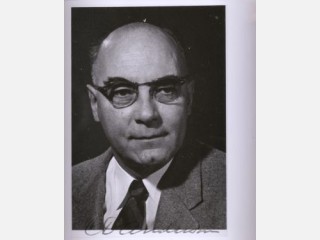
Carl David Anderson biography
Date of birth : 1905-09-03
Date of death : 1991-01-11
Birthplace : New York City, New York, US
Nationality : American
Category : Science and Technology
Last modified : 2011-01-26
Credited as : Physicist, discoveries of antiparticle, Nobel Prize for Physics in 1936
The American physicist Carl David Anderson opened up the whole field of particle physics for research by his discoveries of the first known antiparticle, the positron, and of the meson.
On September 3, 1905, Carl Daveid Anderson was born in New York City of Swedish ancestry. He attended Los Angeles Polytechnic High School and in 1924 entered the California Institute of Technology, with which he would be associated throughout his life. In 1927 Anderson received his bachelor's degree, and then continuing in graduate school as a Coffin research fellow and next as a teaching fellow, he obtained a doctorate magna cum laude in 1930 under the physicist and Nobel laureate R. A. Millikan. After working with Millikan at Cal Tech as a research fellow for 3 years, Anderson was promoted to assistant professor in 1933, to associate professor in 1937, to full professor in 1939, and to chairman of the Division of Physics, Mathematics, and Astronomy in 1962.
In 1946 he married Lorraine Elvira Bergman. The Andersons had two sons, Marshall and David.
In the years immediately after receiving his doctorate Anderson discovered the positron, or positive electron—a revolutionary discovery because the positron became the first known antiparticle and the first known positively charged particle other than the ordinary proton. Anderson made his discovery during his and Millikan's quest to determine the nature of cosmic rays by allowing them to pass through a Wilson cloud chamber immersed in a strong magnetic field. By 1931 he had found evidence indicating that the rays produced charged particles whose tracks are very similar to those produced by ordinary electrons, except that they are bent by the magnetic field in the opposite direction.
Several explanations of these oppositely bent tracks were possible: that they were due to low-energy protons; that they were due to ordinary electrons moving backward; or that they were due to positive electrons. Although the last hypothesis was the most logical, it was also the most radical, and only after Anderson (with the help of S. Neddermeyer) was able to eliminate definitely the first two did he feel compelled to accept the third. His famous photograph taken on August 2, 1932 unambiguously displayed a positron traversing a lead plate placed in the cloud chamber.
By the following spring, P. M. S. Blackett and G. P. S. Occhialini, working independently at the Cavendish Laboratory in England, produced a number of cloud chamber photographs indicating that a positron-electron pair—that is, matter—can be created by a gamma-ray photon (electromagnetic energy) interacting with the intense electromagnetic field surrounding a nucleus. They also recognized, as Anderson at the time had not, that Anderson's positron was the same particle that had been predicted by P. A. M. Dirac's 1928 relativistic quantum-mechanical theory of the electron. (Many physicists had believed Dirac's theory to be imperfect because it entailed the yet unobserved positron!) Subsequent work by Anderson and others established beyond doubt the proper experimental conditions for the materialization and annihilation of positrons.
In 1936 Anderson, again aided by Neddermeyer, made a second important experimental discovery: the existence in cosmic radiation of a very penetrating charged particle with a mass of about 200 electron masses, or of about one-tenth the mass of a proton. Anderson named these intermediate-mass particles mesotrons (later shortened to mesons) and believed them to be identical to the nuclear particle H. Yukawa had theoretically predicted less than 2 years earlier. It was later realized, however, that Anderson's meson is actually the mu meson (or muon), and Yukawa's meson is actually the pi meson (or pion). After World War II Anderson continued to cultivate the field of particle physics, which his momentous 1932 discovery had opened up for research.
Anderson received many honors, beginning, at just 31 years of age, with the Nobel Prize for Physics in 1936, which he shared with V. F. Hess. Anderson's contributions to the war effort earned him the Presidential Certificate of Merit in 1945. He received several honorary doctoral degrees and became a member of the National Academy of Sciences.
Anderson maintained his research and teaching activities until his retirement in 1976 with the title professor emeritus. He died in San Marino, California on January 11, 1991, at the age of 85.
There is a brief biography of Anderson as well as his own description of his prize-winning work in a Nobel Foundation publication, Nobel Lectures Including Presentation Speeches and Laureates' Biographies: Physics, 1922-1941 (1965). Niels H. de V. Heathcote, Nobel Prize Winners in Physics, 1901-1950 (1953), contains a short biography of Anderson. A historical-philosophical treatment of Anderson's discovery is in Norwood R. Hanson, The Concept of the Positron (1963).
















